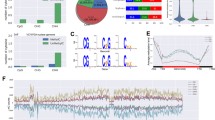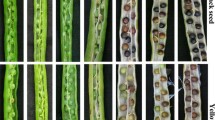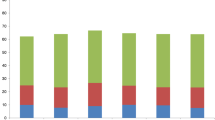Abstract
Background
Saffron (Crocus sativus) is high valued spice crop, but due to its sterile nature, the crop is propagated exclusively through corms. Thus, the genetic base of this crop is very narrow, however, frequency of phenotypic variability is observed; and suggested the potential role of epigenetics in saffron crop growth and development.
Methods and results
To facilitate epigenetic studies in saffron, we developed 1525 methylation-specific PCR (MSP) markers using MethPrimer. For this purpose, we used 6767 EST sequences of saffron available on the NCBI database. We also mine CpG islands (2555) and found that 32.7% of EST sequences had CpG islands. Out of 1525 MSP markers developed during the present study, 725 covered the CpG islands and 800 were without CpG islands. PCR amplification was found successful for 82% of MSP markers. A preliminary analysis suggested that 53.7% of genomic sites were methylated and more prominent (60% methylations) in non-CpG island regions, although, more comprehensive studies are required to validate it further.
Conclusions
The epigenetic resource developed during the present study will strengthen the epigenetic studies like epiQTL mapping, epiGWAS to explore the molecular mechanisms and genomic/epigenomic regions associated with phenotype; and further may be utilized for saffron improvement programs through epibreeding.


Similar content being viewed by others
References
Busconi M, Soffritti G, Stagnati L, Marocco A, Martinez JM, Pascual MDLM, Fernandez JA (2018) Epigenetic stability in Saffron (Crocus sativus L.) accessions during four consecutive years of cultivation and vegetative propagation under open field conditions. Plant Sci J 277:1–10
Iwasaki M, Paszkowski J (2014) Epigenetic memory in plants. EMBO J 33:1987–1998
Springer NM, Schmitz RJ (2017) Exploiting induced and natural epigenetic variation for crop improvement. Nat Rev Genet 18:563–575
Busconi M, Wischnitzki E, Del Corvo M, Colli L, Soffritti G, Stagnati L, Fluch S, Sehr EM, De-Los-Mozos Pascual M, Fernandez JA (2021) Epigenetic variability among saffron crocus (Crocus sativus L.) accessions characterized by different phenotypes. Front Plant Sci 12:349
Grilli Caiola M (2004) Saffron reproductive biology. Acta Hortic 650:25–37. https://doi.org/10.17660/actahortic.2004.650
Busconi M, Colli L, Sanchez RA, Santaella M, De-Los-Mozos Pascual M, Santana O, Roldan M, Fernandez JA (2015) AFLP and MS-AFLP analysis of the variation within saffron crocus (Crocus sativus L.) germplasm. PLoS ONE 10:e0123434. https://doi.org/10.1371/journal.pone.0123434
Niederhuth CE, Bewick AJ, Ji L, Alabady MS, Do KK, Li Q et al (2016) Widespread natural variation of DNA methylation within angiosperms. Genome Biol 17:194
Rawoof A, Chhapekar SS, Jaiswal V, Brahma V, Kumar N, Ramchiary N (2020) Single-base cytosine methylation analysis in fruits of three Capsicum species. Genomics 112:3342–3353
Zuo J, Wang Y, Zhu B, Luo Y, Wang Q, Gao L (2018) Comparative analysis of DNA methylation reveals specific regulations on ethylene pathway in tomato fruit. Genes (Basel) 9:266
Gahlaut V, Zinta G, Jaiswal V, Kumar S (2020) Quantitative epigenetics: a new avenue for crop improvement. Epigenomes 4:25
Li SF, Lv CC, Lan LN, Jiang KL, Zhang YL, Li N, Deng CL, Gao WJ (2021) DNA methylation is involved in sexual differentiation and sex chromosome evolution in the dioecious plant garden asparagus. Hortic Res. https://doi.org/10.1038/s41438-021-00633-9
Li Z, Tang M, Luo D, Kashif MH, Cao S, Zhang W, Hu Y, Huang Z, Yue J, Li R, Chen P (2021) Integrated methylome and transcriptome analyses reveal the molecular mechanism by which DNA methylation regulates kenaf flowering. Front Plant Sci. https://doi.org/10.3389/fpls.2021.709030
Kumar S, Mohapatra T (2021) Dynamics of DNA methylation and its functions in plant growth and development. Front Plant Sci 12:858
Sasaki M, Anast J, Bassett W, Kawakami T, Sakuragi N, Dahiya R (2003) Bisulfite conversion-specific and methylation-specific PCR: a sensitive technique for accurate evaluation of CpG methylation. Biochem Biophys Res Commun 309:305–309
Herman JG, Graff JR, Myohanen SB, Nelkin BD, Baylin SB (1996) Methylation-specific PCR: a novel PCR assay for methylation status of CpG islands. Proc Natl Acad Sci U S A 93:9821–9826
Agayev YM (2002) New features in karyotype structure and origin of saffron, Crocus sativus L. Cytologia 67:245–252
Brandizzi F, Caiola MG (1998) Flow cytometric analysis of nuclear DNA in Crocus sativus and allies (Iridaceae). Plant Syst Evol 211:149–154
Chichiricco G (1984) Karyotype and meiotic behaviour of the triploid Crocus sativus L. Caryologia 37:233–239
Schmidt T, Heitkam T, Liedtke S, Schubert V, Menzel G (2019) Adding color to a century-old enigma: multi-color chromosome identification unravels the autotriploid nature of saffron (Crocus sativus) as a hybrid of wild Crocus cartwrightianus cytotypes. New Phytol 222:1965–1980
Husaini AM, Jimenez AJ (2022) Understanding saffron biology using omics-and bioinformatics tools: stepping towards a better Crocus phenome. Mol Biol Rep 49:1–16
Fluch S, Hohl K, Stierschneider M, Kopecky D, Kaar B (2010) Crocus sativus L. molecular evidence on its clonal origin. III Int Symp Saffron Forthcoming Challenges Cultivation, Res Econ 850:41–46
Siracusa L, Gresta F, Avola G, Albertini E, Raggi L, Marconi G et al (2013) Agronomic, chemical and genetic variability of saffron (Crocus sativus L.) of different origin by LC-UV#vis-DAD and AFLP analyses. Genet Resour Crop Evol 60:711–721
Alsayied NF, Fernandez JA, Schwarzacher T, Heslop-Harrison JS (2015) Diversity and relationships of Crocus sativus and its relatives analysed by inter-retroelement amplified polymorphism (IRAP). Ann Bot 116:359–368
Harpke D, Peruzzi L, Kerndorff H, Karamplianis T, Constantinidis T, Randelovic V et al (2014) Phylogeny, geographic distribution and new taxonomic circumscription of the Crocus reticulatus species group (Iridaceae). Turk J Bot 38:1182–1198
Nemati Z, Harpke D, Gemicioglu A, Kerndorff H, Blattner FR (2019) Saffron (Crocus sativus) is an autotriploid that evolved in Attica (Greece) from wild Crocus cartwrightianus. Mol Phylogenet Evol 136:14–20
Kazemi-Shahandashti S-S, Mann L, El-nagish A, Harpke D, Nemati Z, Usadel B, Heitkam T (2022) Ancient artworks and Crocus genetics both support saffron’s origin in early Greece. Front Plant Sci 13:834416
D’Agostino N, Pizzichini D, Chiusano ML, Giuliano G (2007) An EST database from saffron stigmas. BMC Plant Biol 7:1–8
Gomez LG, Rubio A, Escribano J, Pardo J, Jimenez F, Fernandez JA, Alvarez-Orti M (2003) Development and gene expression in saffron corms. Acta Hortic 650:141–153
Bouck AM, Vision T (2007) The molecular ecologist’s guide to expressed sequence tags. Mol Ecol 16:907–924
Fan M, Gao Y, Wu Z, Haider S, Zhang Q (2022) Evidence for hexasomic inheritance in Chrysanthemum morifolium Ramat. based on analysis of EST-SSR markers. Genome 65:75–81
Zhu B, Luo X, Gao Z, Hu X, Weng Q (2022) De novo transcriptome assembly and development of est-ssr markers of endangered Dendrebium nobile (orchidaceae). Pak J Bot 54:483–489
Li LC, Dahiya R (2002) MethPrimer: designing primers for methylation PCRs. Bioinformatics 18:1427–1431
Sharma M, Gupta P, Mangotra S, Ganjoo S, Trakroo D, Sharma S, Vakhlu J (2021) Isolation and biochemical analysis of bacteria associated with dried stigma of saffron (Crocus sativus). Int J Curr Microbiol App Sci 10:112–126
Rios JL, Recio MC, Giner RM, Manez S (1996) An update review of saffron and its active constituents. Phytother Res 10:189–193
Fernandez JA (2006) Genetic resources of saffron and allies (Crocus spp.). Acta Hortic 739:167–185
Gautam N, Bhattacharya A (2021) Molecular marker-based assessment of genetic homogeneity within the in vitro regenerated plants of Crocus sativus L.–a globally important high value spice crop. S Afr J Bot 140:461–467
Kashtwari M, Wani AA, Dhar MK, Jan S, Kamili AN (2018) Development of an efficient in vitro mutagenesis protocol for genetic improvement of saffron (Crocus sativus L.). Physiol Mol Biol Plants 24:951–962
Khan IA (2003) Induced mutagenic variability in saffron (Crocus sativus L.). Acta Hortic 650:281–283
Samadi N, Naghavi MR, Moratalla-Lopez N, Alonso GL, Shokrpour M (2022) Morphological, molecular and phytochemical variations induced by colchicine and EMS chemical mutagens in Crocus sativus L. Food Chem. https://doi.org/10.1016/j.fochms.2022.100086
Seymour DK, Becker C (2017) The causes and consequences of DNA methylome variation in plants. Curr Opin Plant Biol 36:56–63
Lee HM, Park JS, Shin YH, Park YD (2021) Alterations in DNA methylation patterns in regenerated Chinese cabbage (Brassica rapa ssp. pekinensis) plants derived from tissue culture. Hortic Environ Biotechnol 62:605–618
Parashar NC, Parashar G, Nayyar H, Sandhir R (2021) Differential DNA methylation in regulation of deacetylvindoline-4-O-acetyl transferase (DAT) gene in Catharanthus roseus. J Plant Biochem Biotechnol 30:326–335
Fukushima N, Walter KM, Ueki T, Sato N, Matsubayashi H, Cameron JL, Hruban RH, Canto MI, Yeo CJ, Goggins M (2003) Diagnosing pancreatic cancer using methylation specific PCR analysis. Cancer Biol Ther 2:79–84
Evron E, Dooley WC, Umbricht CB, Rosenthal D, Sacchi N, Gabrielson E, Soito AB, Hung DT, Ljung BM, Davidson NE, Sukumar S (2001) Detection of breast cancer cells in ductal lavage fluid by methylation-specific PCR. Lancet 357:1335–1336
Gallego-Bartolome J, Gardiner J, Liu W, Papikian A, Ghoshal B, Kuo HY, Zhao JM, Segal DJ, Jacobsen SE (2018) Targeted DNA demethylation of the Arabidopsis genome using the human TET1 catalytic domain. PNAS 115:2125-E2134
Tong W, Li R, Huang J, Zhao H, Ge R, Wu Q, Mallano AI, Wang Y, Li F, Deng W, Li Y (2021) Divergent DNA methylation contributes to duplicated gene evolution and chilling response in tea plants. Plant J 106:1312–1327
Yang BC, Lee MS, Lin MK, Chang WT (2021) 5-Azacytidine increases tanshinone production in Salvia miltiorrhiza hairy roots through epigenetic modulation. Sci Rep. https://doi.org/10.21203/rs.3.rs-829034/v1
Bewick AJ, Schmitz RJ (2017) Gene body DNA methylation in plants. Curr Opin Plant Biol 36:103–110
Chen G (2011) Analysis of SSR information in EST resource of saffron crocus (Crocus sativus). Guangxi Zhiwu/Guihaia 31:43–96
Lachheb M, El Merzougui S, Boudadi I, El Caid MB, El Mousadik A, Serghini MA (2022) Assessing genetic diversity using the first polymorphic set of EST-SSRs markers and barcoding of Moroccan saffron. J Appl Res Med Aromat Plants 29:100376
Acknowledgements
This study was supported by the Council of Scientific and Industrial Research (CSIR) for providing funds (MLP-201), V.J. also thanks to the Science and Engineering Research Board (SERB) for the Early Career Research Award and Department of Science and Technology (DST) for the INSPIRE faculty award. VC thanks CSIR-UGC for Junior Research Fellowship. This manuscript represents CSIR-IHBT communication number 5100.
Funding
This study was supported by the Council of Scientific and Industrial Research (CSIR) for providing funds (MLP-201) to Vandana Jaiswal.
Author information
Authors and Affiliations
Contributions
VC- data acquisition, wet-lab experiments, analysis, writing; DS- data acquisition, analysis; AC- data acquisition, analysis; VJ- conceptualization, supervision, writing and editing, fund acquisition.
Corresponding author
Ethics declarations
Conflict of interest
The authors have no conflicts of interest to declare that are relevant to the content of this article.
Ethical approval
Not applicable.
Consent to participate
Not applicable.
Consent to publish
Not applicable.
Additional information
Publisher's Note
Springer Nature remains neutral with regard to jurisdictional claims in published maps and institutional affiliations.
Supplementary Information
Below is the link to the electronic supplementary material.
11033_2022_7967_MOESM1_ESM.xlsx
Supplementary file1 (XLSX 202 KB)Table S1 Details of methylation-specific PCR (MSP) markers developed during present study.
11033_2022_7967_MOESM2_ESM.xlsx
Supplementary file2 (XLSX 13 KB)Table S2 Conserved domain, pfam ID and putative functions of expressed sequence tags (ESTs) from where methylation-specific PCR (MSP) markers were developed and used for PCR amplification in saffron.
11033_2022_7967_MOESM3_ESM.pptx
Supplementary file3 (PPTX 35 KB)Fig. S1 The workflow of MSP marker development and its profiling in saffron plants for detection of methylated and non-methylated sites.
Rights and permissions
Springer Nature or its licensor holds exclusive rights to this article under a publishing agreement with the author(s) or other rightsholder(s); author self-archiving of the accepted manuscript version of this article is solely governed by the terms of such publishing agreement and applicable law.
About this article
Cite this article
Choudhary, V., Shekhawat, D., Choudhary, A. et al. Development of EST-based methylation specific PCR (MSP) markers in Crocus sativus. Mol Biol Rep 49, 11695–11703 (2022). https://doi.org/10.1007/s11033-022-07967-0
Received:
Accepted:
Published:
Issue Date:
DOI: https://doi.org/10.1007/s11033-022-07967-0




